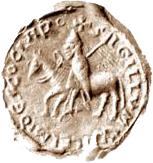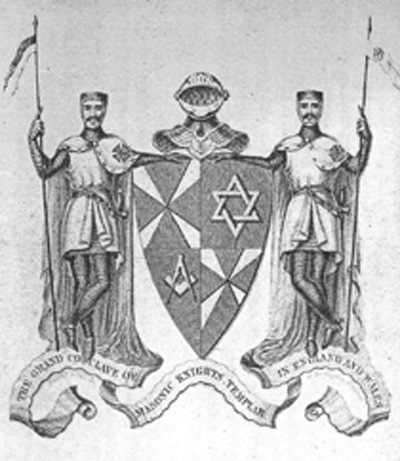Knights Templar
Sir William St. Clair, the third and last Earl of Orkney, founded the Collegiate Church of St. Matthew in 1446, but only the Choir was completed before he died in 1484. After the Reformation, the local presbytery tried to force William, his great grandson, to destroy the altar and all ‘monumentis of idolatrie’ on pain of excommunication. He finally gave up resisting the kirk in 1617, and two years later settled in Ireland.
Since the nineteenth century, many of the chapel’s carvings have been interpreted as symbols connecting Rosslyn Chapel (and the family) to the Knights Templar, warrior monks who protected pilgrims journeying to and from Jerusalem during and after the crusades. Following their disbandment in 1312 by Pope Clement the fifth and Philip the Fair, king of France, it is thought that many settled in Scotland, protected by Robert Bruce.
Father Hay, the genealogist who had access to the earliest Sinclair charters extant at the end of the seventeenth century, never mentioned the Knights Templar, but a manuscript came to light after his death. Supposedly, it was written in 1312 and had been deposited in a square oak box, found under the High Altar of the Templar church in London immediately after the suppression of the Knights of St. John of Jerusalem by Henry VIII in 1540. It was passed directly to the Sinclairs at Rosslyn and transcribed in 1784, but neither the manuscript nor the original transcription have survived. The manuscript began with the following ‘Address to the Devine Being’:
- ADDRESS.
-
-
- WE, the trusty Champions of the Great Emanuel, in this our day of tribulation, Having with reverence and holy fear renewed on this spot our Awful and Glorious ties and Ceremonies, whereunto appertaineth such things as the eyes of man hath not seen, neither hath the heart conceived, save only those who have seen thy Golgotha, who have tasted of thy bitter cup – even from the Valley of Death, think it meet to set down and commit to the Earth as to a Sepulchre some things which may hereafter relight that sacred Fire which for some ages we foresee must be hid in the Hearts of a Chosen few, as in a grave wherein resteth bones – and Rottenness – and contemplation; yet at thy good time those dry bones shall be cloathed, and live, and arise even from this dust, and through weary pilgrimages arrive at thy Holy City, even if thy Holy of Holies — So be it unto us — We will bear thy cross — We have drank before thee, we have tasted of thy cup Jehovah, the cup of thine own workmanship, we have looked with our Eyes wonder and astonishment— We have seen thy wonder of wonders. Our Lord our Head, remember us, shorten this our Rough and Rockey road, take this heavy Burthen from us, Simon – we think upon thee, Horov — awe — and Silence— Oh! Quench not our Glorious Lights, nor extinguish us as the Evil flame that Sold thee — We die this day thy Soldiers, we all perish together as we have lived. — Death cannot part us. Oh! Spare a remnant somewhere to lay up the sacred rules of thy Servant Bernardin: nor cut us clean off, that thy Soldiers fall not from thee forever and thy Temple here on Earth. Oh! Grant that these our last wishes, here deposited in Earth, may hereafter come to light, and bring us who suffer this day to the knowledge of future faithful Brethren and Champions of thy Cross
-
- .
-
The manuscript was the earliest accredited version of the legend by which early Masonic Knights Templar of the English-speaking world sought to connect themselves with the extinct Order of the Temple. Its conveyance from the Templar church in London to Rosslyn soon after 1540 supports the theory that the Sinclairs had some authority, if not a role, amongst early Scottish masons. Building work had stopped on the Collegiate Church 56 years earlier on the death of its founder. In 1602, William Sinclair, great grandson of the founder, was proclaimed patron of the Scottish stone masons in the first Sinclair Charter. A second Charter was issued in 1628, naming his son, Sir William Sinclair of Pentland, as patron. In 1736, William, the ‘Last of the Rosslyns’, resigned his position as Hereditary Grand Master Mason of Scotland. Between 1760 and 1780, the Degree of Masonic Knights Templar had become very popular amongst freemasons, especially in Ireland, where this manuscript and its history of the Knights Templar was widely accepted as the Legend of Succession.
The complete text of the 1784 transcription will be available here shortly.


